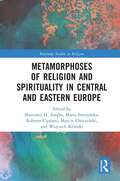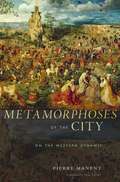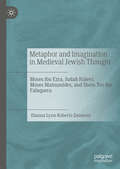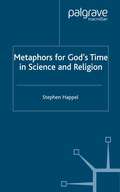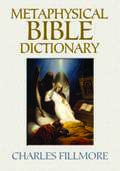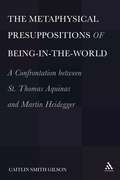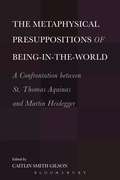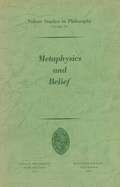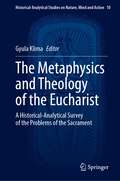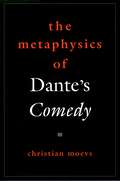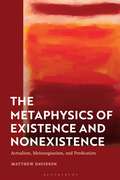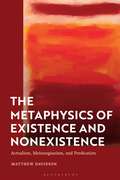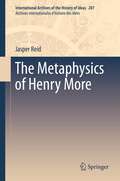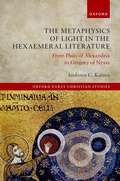- Table View
- List View
Metamorphoses of Religion and Spirituality in Central and Eastern Europe (Routledge Studies in Religion)
by S 322 awomir H. Zarę Ba Maria Sroczy 324 Ska Roberto Cipriani Marcin Choczy 324 Ski Wojciech KlimskiThis book offers a range of contemporary sociological reflections on new manifestations of religion, religiosity, and spirituality in Central and Eastern Europe, a region that has seen significant social and political transformation. It explores the development of cultural and religious trends, including secularisation, new spiritualit,y and a resurgence of religiosity outside of traditional structures. The theoretical and empirical contributions by established and emerging scholars address topics including: the experiences and values of young people, the role and influence of media, the relationship between public and private religion, and the position of state and institutions. The book will be of particular interest to sociologists of religion and others focused on contemporary Central and Eastern European societies.
Metamorphoses of Religion and Spirituality in Central and Eastern Europe (Routledge Studies in Religion)
by Sławomir H. ZarębaThis book offers a range of contemporary sociological reflections on new manifestations of religion, religiosity, and spirituality in Central and Eastern Europe, a region that has seen significant social and political transformation. It explores the development of cultural and religious trends, including secularisation, new spiritualit,y and a resurgence of religiosity outside of traditional structures. The theoretical and empirical contributions by established and emerging scholars address topics including: the experiences and values of young people, the role and influence of media, the relationship between public and private religion, and the position of state and institutions. The book will be of particular interest to sociologists of religion and others focused on contemporary Central and Eastern European societies.
Metamorphoses of the City: On The Western Dynamic
by Pierre ManentMetamorphoses of the City is a sweeping interpretation of Europe's ambition to generate ever better forms of collective self-government, from ancient city-states and empires to a universal church and the nation-state. But the nation-state is nearing the end of its line, Pierre Manent says, and what will supplant it remains to be seen.
Metamorphoses of the City: On The Western Dynamic
by Pierre ManentMetamorphoses of the City is a sweeping interpretation of Europe's ambition to generate ever better forms of collective self-government, from ancient city-states and empires to a universal church and the nation-state. But the nation-state is nearing the end of its line, Pierre Manent says, and what will supplant it remains to be seen.
Metaphor and Imagination in Medieval Jewish Thought: Moses ibn Ezra, Judah Halevi, Moses Maimonides, and Shem Tov ibn Falaquera
by Dianna Lynn Roberts-ZaudererThis book reveals how Moses ibn Ezra, Judah Halevi, Moses Maimonides, and Shem Tov ibn Falaquera understood metaphor and imagination, and their role in the way human beings describe God. It demonstrates how these medieval Jewish thinkers engaged with Arabic-Aristotelian psychology, specifically with regard to imagination and its role in cognition. Dianna Lynn Roberts-Zauderer reconstructs the process by which metaphoric language is taken up by the imagination and the role of imagination in rational thought. If imagination is a necessary component of thinking, how is Maimonides’ idea of pure intellectual thought possible? An examination of select passages in the Guide, in both Judeo-Arabic and translation, shows how Maimonides’ attitude towards imagination develops, and how translations contribute to a bifurcation of reason and imagination that does not acknowledge the nuances of the original text. Finally, the author shows how Falaquera’s poetics forges a new direction for thinking about imagination.
Metaphor, Ritual, and Order in John 12-13: Judas and the Prince (Routledge Interdisciplinary Perspectives on Biblical Criticism)
by Todd E. KlutzThis book offers new interpretative insight into the Gospel of John, applying a combination of critical discourse analysis, conceptual metaphor theory, and anthropological theories of ritual. Specifically it explores the meaning of the statement “Now the ruler of this world will be driven out” in John 12:31 and defends a widely overlooked alternative reading. The author proposes a prophecy-fulfilment scheme whereby this predictive utterance by Jesus’ is subsequently implied as fulfilled in the departure of the satanically-possessed Judas’ from the circle of Jesus’ disciples at the Last Supper in John 13:30. Addressing several major strands relating to purity, exorcism, and group identity, the analysis provides an important entry-point for a fresh examination of the Fourth Gospel as a whole. The book represents a significant contribution to Johannine scholarship and to New Testament studies and will be of interest to scholars of religion, theology and biblical studies.
Metaphor, Ritual, and Order in John 12-13: Judas and the Prince (Routledge Interdisciplinary Perspectives on Biblical Criticism)
by Todd E. KlutzThis book offers new interpretative insight into the Gospel of John, applying a combination of critical discourse analysis, conceptual metaphor theory, and anthropological theories of ritual. Specifically it explores the meaning of the statement “Now the ruler of this world will be driven out” in John 12:31 and defends a widely overlooked alternative reading. The author proposes a prophecy-fulfilment scheme whereby this predictive utterance by Jesus’ is subsequently implied as fulfilled in the departure of the satanically-possessed Judas’ from the circle of Jesus’ disciples at the Last Supper in John 13:30. Addressing several major strands relating to purity, exorcism, and group identity, the analysis provides an important entry-point for a fresh examination of the Fourth Gospel as a whole. The book represents a significant contribution to Johannine scholarship and to New Testament studies and will be of interest to scholars of religion, theology and biblical studies.
Metaphors for God's Time in Science and Religion (Cross Currents in Religion and Culture)
by S. HappelMetaphors for God's Time in Science and Religion examines the exploratory work of metaphors for time in astrophysical cosmology, chaos theory, evolutionary biology and neuroscience. Happel claims that the Christian God is intimately involved at every level of physical and biological science. He compares how scientists and theologians both generate stories, metaphors and symbols about the universe and asks 'who is the God who invents me?
Metaphors of Eucharistic Presence: Language, Cognition, and the Body and Blood of Christ
by Stephen R. ShaverIn Metaphors of Eucharistic Presence: Language, Cognition, and the Body and Blood of Christ, Stephen R. Shaver brings together the fields of cognitive linguistics and liturgical theology to propose a new approach to the ecumenically controversial issue of eucharistic presence. Drawing from the work of cognitive linguists such as George Lakoff, Gilles Fauconnier, and Mark Turner, and theologians such as Robert Masson and John Sanders, Shaver argues that there is no clear division between literal and figurative language: rather, human cognition is grounded in sensorimotor experience, and phenomena such as metaphor and conceptual blending are basic building blocks of thought. Complex realities are ordinarily understood by means of more than one metaphor. Inherited models of eucharistic presence, then, are not necessarily mutually exclusive but can serve as complementary members of a shared ecumenical repertoire. The central element of this repertoire is the motif of identity--the eucharistic bread and wine are the body and blood of Christ--grounded in the Synoptic and Pauline institution narratives. From a cognitive standpoint, this metaphor can be understood both as figurative and as true in the proper sense, resolving a dichotomy that has divided the churches since the Reformation. The identity motif is complemented by four major non-scriptural motifs: representation, change, containment, and conduit. Inaugurating a new interdisciplinary conversation, this book contributes to ongoing ecumenical reconciliation not only by addressing eucharistic presence but also by demonstrating an approach which may hold promise in other historically controverted areas. Meanwhile for cognitive linguists it offers an intriguing case study in the application of that discipline to theological questions.
Metaphors of Eucharistic Presence: Language, Cognition, and the Body and Blood of Christ
by Stephen R. ShaverIn Metaphors of Eucharistic Presence: Language, Cognition, and the Body and Blood of Christ, Stephen R. Shaver brings together the fields of cognitive linguistics and liturgical theology to propose a new approach to the ecumenically controversial issue of eucharistic presence. Drawing from the work of cognitive linguists such as George Lakoff, Gilles Fauconnier, and Mark Turner, and theologians such as Robert Masson and John Sanders, Shaver argues that there is no clear division between literal and figurative language: rather, human cognition is grounded in sensorimotor experience, and phenomena such as metaphor and conceptual blending are basic building blocks of thought. Complex realities are ordinarily understood by means of more than one metaphor. Inherited models of eucharistic presence, then, are not necessarily mutually exclusive but can serve as complementary members of a shared ecumenical repertoire. The central element of this repertoire is the motif of identity--the eucharistic bread and wine are the body and blood of Christ--grounded in the Synoptic and Pauline institution narratives. From a cognitive standpoint, this metaphor can be understood both as figurative and as true in the proper sense, resolving a dichotomy that has divided the churches since the Reformation. The identity motif is complemented by four major non-scriptural motifs: representation, change, containment, and conduit. Inaugurating a new interdisciplinary conversation, this book contributes to ongoing ecumenical reconciliation not only by addressing eucharistic presence but also by demonstrating an approach which may hold promise in other historically controverted areas. Meanwhile for cognitive linguists it offers an intriguing case study in the application of that discipline to theological questions.
The 'Metaphysica' of Avicenna: A critical translation-commentary and analysis of the fundamental arguments in Avicenna's 'Metaphysica' in the 'Dānish Nāma-i 'alā'ī' ('The Book of Scientific Knowledge') (Routledge Library Editions: Islamic Thought in the Middle Ages)
by Parviz MorewedgeIn this book, first published in 1973, Professor Parviz Morewedge, an expert on Islamic philosophy and mysticism, provides a critical exposition of one text of ibn Sina (Avicenna), the great Persian philosopher who lived from 980 to 1037. The text is his Metaphysica in the Danish Nama-I ‘ala’I (The Book of Scientific Knowledge). In addition to a translation of the text from Persian into English, this edition includes a critical commentary on the major arguments found in the text, and notes and references to other texts of ibn Sina as well as to relevant texts of Greek philosophers, particularly Aristotle, Plotinus and Proclus. There is also a glossary of the key terms used in the Metaphysica, with their Persian, Arabic, Greek and Latin equivalents where necessary. This book is concerned primarily to show that although in the text ibn Sina resorts to the Aristotelian vocabulary and Neo-Platonic themes, and appears to be in accord with the Islamic tradition, there is evidence that many doctrines expressed by him may be considered non-Greek and non-Islamic. These include his peculiar doctrine of Self (nafs) and the doctrine of the Necessary Existent (wajib al-wujud). The author attempts to clarify the extent to which salient features of ibn Sina’s position are in agreement with what may be regarded as Sufic doctrines.
The 'Metaphysica' of Avicenna: A critical translation-commentary and analysis of the fundamental arguments in Avicenna's 'Metaphysica' in the 'Dānish Nāma-i 'alā'ī' ('The Book of Scientific Knowledge') (Routledge Library Editions: Islamic Thought in the Middle Ages)
by Parviz MorewedgeIn this book, first published in 1973, Professor Parviz Morewedge, an expert on Islamic philosophy and mysticism, provides a critical exposition of one text of ibn Sina (Avicenna), the great Persian philosopher who lived from 980 to 1037. The text is his Metaphysica in the Danish Nama-I ‘ala’I (The Book of Scientific Knowledge). In addition to a translation of the text from Persian into English, this edition includes a critical commentary on the major arguments found in the text, and notes and references to other texts of ibn Sina as well as to relevant texts of Greek philosophers, particularly Aristotle, Plotinus and Proclus. There is also a glossary of the key terms used in the Metaphysica, with their Persian, Arabic, Greek and Latin equivalents where necessary. This book is concerned primarily to show that although in the text ibn Sina resorts to the Aristotelian vocabulary and Neo-Platonic themes, and appears to be in accord with the Islamic tradition, there is evidence that many doctrines expressed by him may be considered non-Greek and non-Islamic. These include his peculiar doctrine of Self (nafs) and the doctrine of the Necessary Existent (wajib al-wujud). The author attempts to clarify the extent to which salient features of ibn Sina’s position are in agreement with what may be regarded as Sufic doctrines.
The Metaphysical Anthropology of Julián Marías (Palgrave Frontiers in Philosophy of Religion)
by Alberto OyaThis book provides a detailed account of Julián Marías’s metaphysical anthropology with the ultimate aim of offering a coherent and systematic analysis of Marías’s argumentation for claiming that the conscious hope for Christian salvation through resurrection — and with it the hope that Jesus Christ did actually resurrect, and more generally the hope that Christian revelation is true — is justified not because the certainty or the likelihood that this salvation will, as a matter of fact, actually occur, but because this hope amounts to a self-affirming exercise, a conscious endorsement of human reality, and as such a sign of authenticity.
Metaphysical Bible Dictionary (Dover Empower Your Life Ser.)
by Charles FillmoreA notable product of the 19th-century New Thought revolution, Charles Fillmore's Unity movement combined esoteric and metaphysical principles with traditional Christian elements. This key to Fillmore's original form of religious expression, a core text of the Unity movement, interprets the hidden meanings of the Bible's myriad names, places, and events.
The Metaphysical Presuppositions of Being-in-the-World: A Confrontation Between St. Thomas Aquinas and Martin Heidegger
by Caitlin Smith GilsonThis book brings Aquinas and Heidegger into dialogue and offers an original and comprehensive rethinking of the nature of temporality and the origins of metaphysical inquiry.
The Metaphysical Presuppositions of Being-in-the-World: A Confrontation Between St. Thomas Aquinas and Martin Heidegger
by Caitlin Smith GilsonThis book brings Aquinas and Heidegger into dialogue and offers an original and comprehensive rethinking of the nature of temporality and the origins of metaphysical inquiry.
The Metaphysics and Theology of the Eucharist: A Historical-Analytical Survey of the Problems of the Sacrament (Historical-Analytical Studies on Nature, Mind and Action #10)
by Gyula KlimaThis volume is about the most mind-boggling sacrament of the Christian faith, also referred to as the Sacrament of the Altar, the Eucharist: in its Roman Catholic interpretation, the conversion of the substance of the bread and wine into the body and blood of Christ for Holy Communion. The challenge of providing a rational interpretation of this doctrine of faith proved to be one of the most contentious issues in the Western history of ideas, apparently going against self-evident metaphysical principles (requiring accidents existing without a substance, and a body in several places at the same time, etc.), and dividing schools of thought, indeed, eventually, warring religious factions. The volume addresses both the metaphysical, theoretical issues involved in this challenge and the historical, theological developments of how meeting this challenge played out first in the schools and even later in religious schisms, leading to the paradigmatic shift from medieval to modern forms of thought. The essays of the volume derive from the lectures of an eponymous international conference held in Budapest, Hungary, which was also the occasion of founding the Society for the History of European Ideas (SEHI); accordingly, the book is the first volume of the annual Proceedings of the SEHI. This book is aimed just as much at laymen and religious scholars seeking a better understanding of their faith as at anyone seeking this understanding with a non-religious attitude.
The Metaphysics of Christology in the Late Middle Ages: William of Ockham to Gabriel Biel (Changing Paradigms in Historical and Systematic Theology)
by Prof Richard CrossThe late middle ages was a period of great speculative innovation in Christology, within the framework of a standard Christological opinion established by the Franciscan John Duns Scotus and the Dominican Hervaeus Natalis. According to this view, the Incarnation consists in some kind of dependence relationship between an individual human nature and a divine person. The Metaphysics of Christology in the Late Middle Ages: William of Ockham to Gabriel Biel explores ways in which this standard opinion was developed in the late middle ages. Theologians offered various proposals about the nature of the relationship—as a categorial relation, or an absolute quality, or even just the divine will. Author Richard Cross also considers alternative positions: Peter Auriol's claim that the divine person is a 'quidditative termination' of the human nature; the homo assumptus theology of John Wyclif and Jan Hus; and the retrieval of a truly Thomistic Christology in the fifteenth century in the thought of John Capreolus and Denys the Carthusian. The fourteenth and fifteenth centuries were pre-eminently the age of nominalism, and this book examines the impact of nominalism on Christological discussions, as well as the development of Thomist and Scotist theology in the period. It also provides essential background for the correct understanding of Reformation Christology.
The Metaphysics of Christology in the Late Middle Ages: William of Ockham to Gabriel Biel (Changing Paradigms in Historical and Systematic Theology)
by Prof Richard CrossThe late middle ages was a period of great speculative innovation in Christology, within the framework of a standard Christological opinion established by the Franciscan John Duns Scotus and the Dominican Hervaeus Natalis. According to this view, the Incarnation consists in some kind of dependence relationship between an individual human nature and a divine person. The Metaphysics of Christology in the Late Middle Ages: William of Ockham to Gabriel Biel explores ways in which this standard opinion was developed in the late middle ages. Theologians offered various proposals about the nature of the relationship—as a categorial relation, or an absolute quality, or even just the divine will. Author Richard Cross also considers alternative positions: Peter Auriol's claim that the divine person is a 'quidditative termination' of the human nature; the homo assumptus theology of John Wyclif and Jan Hus; and the retrieval of a truly Thomistic Christology in the fifteenth century in the thought of John Capreolus and Denys the Carthusian. The fourteenth and fifteenth centuries were pre-eminently the age of nominalism, and this book examines the impact of nominalism on Christological discussions, as well as the development of Thomist and Scotist theology in the period. It also provides essential background for the correct understanding of Reformation Christology.
The Metaphysics of Dante's Comedy (AAR Reflection and Theory in the Study of Religion)
by Christian MoevsDante's metaphysics--his understanding of reality--is very different from our own. To present Dante's ideas about the cosmos, or God, or salvation, or history, or poetry within the context of post-Enlightenment presuppositions, as is usually done, is thus to capture only imperfectly the essence of those ideas. The recovery of Dante's metaphysics is essential, argues Christian Moevs, if we are to resolve what has been called "the central problem in the interpretation of the Comedy ." That problem is what to make of the Comedy 's claim to the "status of revelation, vision, or experiential record--as something more than imaginative literature." In this book Moevs offers the first sustained treatment of the metaphysical picture that grounds and motivates the Comedy , and of the relation between those metaphysics and Dante's poetics. He carries this out through a detailed examination of three notoriously complex cantos of the Paradiso , read against the background of the Neoplatonic and Aristotelian tradition from which they arise. Moevs finds the key to the Comedy 's metaphysics and poetics in the concept of creation, which implies three fundamental insights into the nature of reality: 1) The world (finite being) is radically contingent, dependent at every instant on what gives it being. 2) The relation between the world and the ground of its being is non-dualistic. (God is not a thing, and there is nothing the world is "made of") 3) Human beings are radically free, unbound by the limits of nature, and thus can find all of time and space within themselves. These insights are the foundation of the pilgrim Dante's journey from the center of the world to the Empyrean which contains it. For Dante, in sum, what we perceive as reality, the spatio-temporal world, is a creation or projection of conscious being, which can only be known as oneself. Moevs argues that self-knowledge is in fact the keystone of the Aristotelian and Neoplatonic philosophical tradition, and the essence of the Christian revelation in which that tradition culminates. Armed with this new understanding, Moevs is able to shed light on a series of perennial issues in the interpretation of the Comedy . In particular, it becomes clear that poetry coincides with theology and philosophy in the poem: Dante poeta cannot be distinguished from Dante theologus .
The Metaphysics of Existence and Nonexistence: Actualism, Meinongianism, and Predication
by Matthew DavidsonAre there nonexistent objects? Can we make sense of objects having properties without thinking that there are nonexistent objects? Is existence a predicate? Can we make sense of necessarily existing objects depending on God? Tackling these central questions, Matthew Davidson explores the metaphysics of existence and nonexistence. He presents an extended argument for independence actualism, a previously undefended view that objects can have properties in worlds and at times at which they do not exist. Among other unique points of discussion, Davidson considers the nature of actualism, arguments for and against serious actualism, the semantics of “exists” as a predicate, the merits of different sorts of Meinongian theories, and different views on which God might ground the existence of necessarily existing abstracta. The book offers a Lewisian-style argument for adopting independence actualism in that the view may be used to solve many problems in metaphysics, philosophy of language and philosophy of religion.
The Metaphysics of Existence and Nonexistence: Actualism, Meinongianism, and Predication
by Matthew DavidsonAre there nonexistent objects? Can we make sense of objects having properties without thinking that there are nonexistent objects? Is existence a predicate? Can we make sense of necessarily existing objects depending on God? Tackling these central questions, Matthew Davidson explores the metaphysics of existence and nonexistence. He presents an extended argument for independence actualism, a previously undefended view that objects can have properties in worlds and at times at which they do not exist. Among other unique points of discussion, Davidson considers the nature of actualism, arguments for and against serious actualism, the semantics of “exists” as a predicate, the merits of different sorts of Meinongian theories, and different views on which God might ground the existence of necessarily existing abstracta. The book offers a Lewisian-style argument for adopting independence actualism in that the view may be used to solve many problems in metaphysics, philosophy of language and philosophy of religion.
The Metaphysics of Henry More (International Archives of the History of Ideas Archives internationales d'histoire des idées #207)
by Jasper ReidThe book surveys the key metaphysical contributions of the Cambridge Platonist, Henry More (1614–1687). It deals with such interwoven topics as: the natures of body and spirit, and the question of whether or not there is a sharp ontological division between them; the nature of spatial extension in relation to each; the composition and governance of the physical world, including More’s theories of Hyle, atoms, vacuum, and the Spirit of Nature; and the life of the human soul, including its pre-existence. It approaches these topics and the systematic connections between them both historically and analytically, and seeks to do justice to the ways in which More’s system developed and changed—sometimes quite dramatically—over the course of his long career. It also explores More's intellectual relations with both his own inspirations (Plotinus, Origen, Ficino, Descartes, etc.) and with those who responded, whether positively or negatively, to his work (Leibniz, Locke, Boyle, Newton, etc.).
The Metaphysics of Light in the Hexaemeral Literature: From Philo of Alexandria to Gregory of Nyssa (Oxford Early Christian Studies)
by Isidoros C. KatsosThis volume critically re-evaluates the received interpretation of the nature of light in the ancient sources. Isidoros C. Katsos contests the prevalent view in the history of optics according to which pre-modernity theorized light as subordinate to sight ('oculocentrism') by examining in depth the contrary textual evidence found in early Christian texts. It shows that, from Philo of Alexandria and Origen to Basil of Caesarea and Gregory of Nyssa, the Jewish-Christian commentary tradition on the hexaemeral literature (the biblical creation narrative) reflected deeply on the nature and physicality of light for the purposes of understanding the structure and purpose of material creation. Contemplation of nature allowed early Christian thinkers to conceptualize light as the explanatory principle of vision rather than subordinated to it. Contrary to the prevalent view, the hexaemeral literature necessitates a 'luminocentric' interpretation of the theory of light of Plato's Timaeus in its reception history in the context of late antique cosmology. Hexaemeral luminocentrism invites the reader of Scripture to grasp not only the sensible properties of light, but also their causal principle as the first manifestation of the divine Logos in creation. The hexaemeral metaphysics thus provides the missing ground of meaning of the early Christian language of light.
